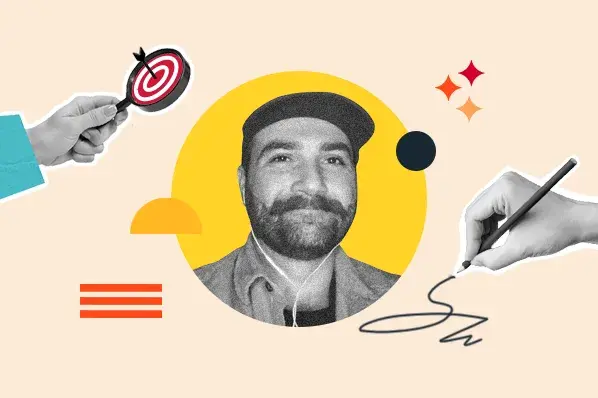Welcome to Creator Columns, the place we convey knowledgeable HubSpot Creator voices to the Blogs that encourage and assist you to develop higher.
Months earlier than Beau was born, my sister — herself a mom of three — really helpful we put a “NoseFrida” on our registry.
“It’s this rubber tube,” she mentioned. “One finish goes within the child’s nostril, the opposite goes in your mouth. Then you definitely suck.” I laughed. Being childless on the time, this was a surprising idea. “It’s clear,” she mentioned, “there’s a booger-catcher factor within the center.” I laughed once more. “Nothing goes in your mouth.”
I checked out my spouse. “I’m not doing that.” She rolled her eyes and palmed her stomach.
Months after Beau is born:
He’s nonetheless very small. I’m on the sofa, horizontal, mendacity on my again, holding him above my head. My elbows are bending. I’m shifting him up and down. We’re enjoying, laughing. My mouth is open.
Beau spits up.
My mouth is all of a sudden full. It’s breast milk — not too long ago consumed and now regurgitated — however I’m not phased, imagine it or not. My son is three months outdated, in spite of everything. Unusual issues occur. I have a look at my spouse. She’s cackling at my misfortune. I rise up and move her the boy and go to the sink and spit.
“Kels—” I name out.
“Yeah?”
“Have you ever seen the nostril factor?” I mentioned. “He’s stuffy.”
The day Beau was born:
Kelsey woke me up early. It was nonetheless darkish exterior. Gentle from the toilet poured into the bed room. “My water broke,” she mentioned.
We drove to the hospital. We went by way of triage. We met the nurse and the physician and settled into the supply room. “This can be a course of,” mentioned the nurse. “Attempt to get comfy.”
We tried. I closed the blinds and dimmed the lights and adjusted my spouse’s hospital mattress till she mentioned, “That feels good.” The room was darkish and quiet, calm. Kels fell asleep. Her again was to me. I used to be sitting in a recliner, studying one thing, listening to my son’s heartbeat come by way of the fetal monitor.
I closed my eyes. The door opened. My eyes opened. “Okay—” mentioned the nurse, “we’ve got a grumpy child in there—” Kels sat up. I stood up. “I’m gonna have you ever roll over—” the nurse informed my spouse.
Then, all of a sudden, one other nurse walked in. And one other. And one other. Then the obstetrician walked in. Then the anesthesiologist. Out of the blue, a dozen individuals surrounded my spouse, shifting her this manner and that approach, propping her up. “It’s gonna be positive, expensive—” mentioned the nurse, “simply breathe, expensive, breathe—”
I backed up till my heel hit the wall. I used to be within the nook now. My spouse was on her knees and elbows now. I couldn’t see her face anymore. A physician approached me. “Dad?” I checked out her. “The boy’s coronary heart fee simply dropped.”
“Dropped?”
“Sure,” she mentioned. “One-ten to one-sixty is regular in utero—” I regarded on the monitor. It was beeping and bouncing: fifty-four, fifty-seven, fifty-two. “It is within the fifties now,” she mentioned.
“Why?” I mentioned. My palms had been moist.
“Most likely the umbilical wire—” the physician saved speaking, elaborating, however I might solely see my spouse and listen to the monitor and really feel my throat tightening.
Then, all of a sudden, the beeping stopped. “Coronary heart fee stabilized,” somebody mentioned, and the room cleared out as rapidly because it had crammed up.
Then, all of a sudden, it was simply me and my spouse and the physician, who mentioned, “This will’t hold taking place.”
“However what truly occurred?” my spouse requested.
The physician repeated herself. “The umbilical wire,” she mentioned, “it’s compromised.” Then she informed us if the guts fee deceleration saved taking place, an emergency cesarean could be vital. Kelsey squeezed my hand. I squeezed again. An hour later, it occurred once more. And once more after that.
“Okay,” mentioned my spouse, and signed the legal responsibility kind.
“Okay,” mentioned the physician, and the nurses started rolling Kelsey’s mattress towards the working room. Earlier than she turned the nook, we signed I Love You to one another.
Three fingers. Then, all of a sudden, it was simply me. I used to be alone, sitting there, choosing the pores and skin off my thumb and tapping my foot. I regarded down. My thumb was bleeding. I ended choosing and put it in my mouth.
I’m a secular particular person, however in that second, I started to wish. “God—” I regarded down. The blood was pooling in my cuticle. I let it go. “Please—” I didn’t know what I used to be doing. “Please—” I didn’t know find out how to speak to God. “Please, Lord—” I started bartering with Him. “I swear to you,” I mentioned, “I’ll be one of the best dad.”
The second Beau is born:
Within the working room, when the surgeon lifts him up over the blue curtain and I see him for the primary time, I acknowledge him. A lot so, actually, it takes my breath away. I gasp. I do know this particular person. I do know his face.
It seems like whenever you run into an outdated pal, somebody you left behind, they usually’ve modified, in fact — time has modified them — however you continue to see them as you as soon as knew them. That is what it feels just like the second Beau is born. It seems like I already know him.
The surgeon passes the boy to a nurse. “Apgar at one and 5—” he says.
“Sure, Physician,” says the nurse.
“And I want suction on the left—” he says in the identical breath.
“Sure, Physician,” says one other nurse.
“Extra—”
“Sure, Physician.”
Beau is in a small room now, adjoining to the OR. He must be cleaned and measured and weighed. I have a look at Kelsey. “Go meet him,” she says.
A 12 months after Beau was born, I did a writing experiment.
I requested one of many huge AI engines a query:
“Are you able to describe assembly your firstborn youngster?”
The pc thought for a second, then produced 88 phrases:

I learn it, then wrote my very own model, besides I restricted myself to precisely as many phrases because the AI’s passage. I usually practice writing this way. Effectivity, in spite of everything, is my bread and butter as a copywriter. Phrase economic system is baked into the self-discipline. Saying extra in fewer phrases isn’t a foul factor:

Once I shared it in my newsletter and on LinkedIn, the response was outstanding. The idea, clearly, struck a nerve. Lots of of 1000’s of individuals noticed the experiment, prompting over a thousand feedback, DMs, and emails. All that suggestions culminated in a consensus: my model is best.
Readers mentioned that regardless of utilizing solely as many phrases because the AI, my passage created a lot richer, extra vivid imagery: “I might truly see your model,” somebody commented. “It felt like a film was enjoying in my head.”
“Thoughts Films” are an actual phenomenon.
Harvard psychologist Stephen Kosslyn calls it “Psychological Imagery,” or the “replica of visible photos within the absence of the stimuli themselves.”
Thoughts Films will be self-inflicted — an athlete, for instance, may think herself making the game-winning shot — or, they are often finished to us, prompted by writing.
However how? I’ll let you know precisely:
You’ll be able to put “holes” in your writing.
In different phrases, go away issues out — particulars, context — and this may give The Reader an opportunity to “fill in” that house, to make use of her creativeness, to entry her personal experiences, or reminiscences, good or unhealthy, painful or nice.
Holes invite The Reader to take part within the narrative.
However how do you create holes? I’ll let you know precisely:
1. Anti-description
For instance, I don’t have to inform you I’m in a hospital:

You fill on this gap for your self as a result of I point out “the nurse,” and “masks” and “robes” and “gloves” and “hairnets.” These context clues are sufficient to conjure the colours, smells, and sterility of a hospital.
I’m not providing you with an outline as a lot as an anti-description — small particulars that pressure you to paint within the story based mostly in your personal experiences in a hospital, creating a picture that’s invariably extra actual and plausible.
This technique of filling within the particulars for your self — even when they’re not completely correct — just isn’t solely partaking, however may conjure profoundly vivid imagery, the fodder of a “Thoughts Film.”
One other approach this phenomenon expresses itself is by way of The Kuleshov Impact, found by movie researcher Lev Kuleshov, who did an experiment. He put an actor in entrance of a digital camera and requested him to ship an expressionless look. The actor, somebody named Ivan Mosjoukine, did this:

Then, Kuleshov confirmed audiences a collection of photographs, adopted by Mosjoukine’s expressionless face.
He confirmed them a bowl of soup:

He confirmed them a small lady in a coffin:

He confirmed them a girl on a fainting sofa:

In his guide, The Power of Film, movie professor Howard Suber explains the importance of this experiment.
“Audiences raved on the vary of this nice actor,” says Suber, “How he expressed how famished he was in entrance of that bowl of soup. And the way heartbroken he was at his youngster — nothing had recognized any relationship between the kid and the actor; the viewers learn that story into it,” says Suber. “And the lady on the sofa … need.”

“What Kuleshov proved is you don’t need theatrical performing during which the actor initiatives to the again of the home,” explains Suber. “The actor doesn’t have to venture. The viewers is projecting onto the actor the feelings they suppose the actor is feeling, though the actor isn’t expressing any emotion.”
Mosjoukine’s “expressionless look” in movie is like “anti-description” in writing: by giving The Reader much less, you’re truly giving them extra to think about, visualize, and expertise.
2. Dialogue
For instance, I don’t have to let you know I’m anxious on this scene:

You fill on this gap for your self, based mostly on what I’m saying, the observations I’m stating, and the questions I’m asking. That is also called subtext. It’s the true that means behind what characters say — and it’s one in all our salient benefits as human writers.
For instance, I’m not merely saying “Whats up” to my son:

Ostensibly it’s a greeting, however it’s truly me turning into a brand new particular person. On this second, the outdated particular person, the childless particular person — the one which wouldn’t even think about using a NoseFrida — is gone. On this second, my priorities and worldview have modified, irreversibly so. I’ve remodeled.
You fill on this gap for your self by letting the context — the circumstance, the setting — dictate the that means.
That is in stark distinction to the AI’s method.
The pc lacks consciousness. It’s not conscious of itself, a lot much less the human situation. It will possibly’t comprehend the essence of an individual, or the importance of a second, a lot much less this second, the gravity and complexity of assembly your firstborn youngster.
So, as a substitute, the AI spoon-feeds us a collection of platitudes and cliches, an amalgamation of some ideally suited state of affairs, some model of perfection:

It falls flat, in fact, as a result of it’s simply not that straightforward.
“The AI’s model might be correct (for some no less than), however it lacks the heat and actuality of holding your youngster for the primary time,” explains fellow author and mum or dad, Katie Murray, in a touch upon my submit.
“As a first-time mum or dad, I used to be ecstatic and anxious in equal measure as I held my stunning child for the primary time. You acknowledge the fun and the accountability of being a mum or dad concurrently, and nothing fairly prepares you for both.”
The AI can’t perceive this duality as a result of it’s not alive. It didn’t stay this second, so it might probably’t relate.
It didn’t simply watch a very powerful particular person in its life undergo 36 hours of laborious, difficult labor. It didn’t witness its unborn youngster struggling to breathe contained in the womb of this particular person.
It wasn’t there throughout emergency surgical procedure at 4 o’clock within the morning, sitting by its spouse, holding her head, telling her every little thing goes to be okay when there was a really actual chance that it wouldn’t be … that one thing horrible and unthinkable may occur to its household, to their future collectively, to their love.
Persons are probably the most unimaginable animals as a result of, daily, we undergo life with the information that every little thing we care about, every little thing we love, may very well be taken from us. And but, we go on anyway. Day-after-day, we persist.
And generally, we’re reminded of this actuality, and it does one thing to us, and that’s why I wrote what I wrote. I wrote my fact. And since all of us share the human expertise, so many individuals understood that fact.
They associated to my model, my expertise — they usually had been equally underwhelmed by the model put forth by the AI.
For this reason copywriting will all the time be a human career.
As a result of writing is definitely not our work.
“[Writing] an ideal advert,” mentioned inventive director Jeff Goodby,” is [putting] a mirror in entrance of your viewers.”
Writing is necessary, in fact, and hopefully, the dialogue, anti-description, and subtext I created illustrates the large chasm between a human’s flip of phrase and that of a machine. Besides, if that chasm had been to shut — years or many years into the long run, if ever — I hope each copywriter studying this finds solace in the truth that writing is simply our medium, the vessel by way of which we put a mirror in entrance of our viewers, and replicate one thing patently human and imperfect and true.


